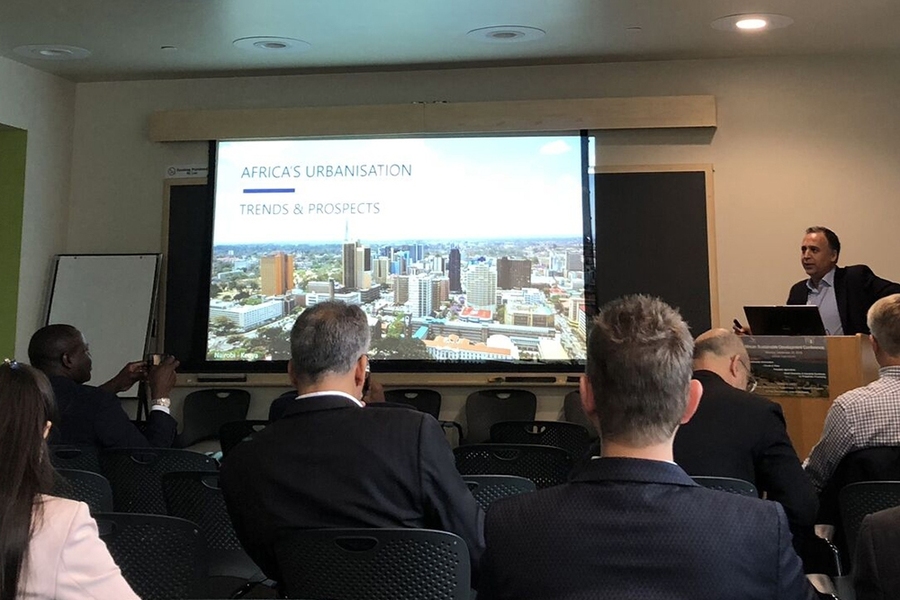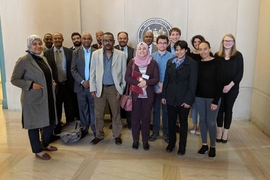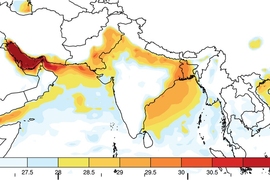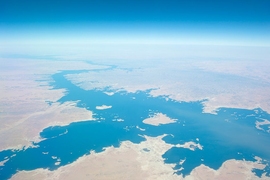Climate change, a surging population, and increasing demand for food, housing and natural resources present Africa and the world with extraordinary challenges.
On Sept. 24, numerous experts from diverse disciplines and areas of the world convened at MIT to discuss sustainable development in Africa. The conference was hosted by the Université Mohammed VI Polytechnique-MIT Research Program (UMRP), a collaboration with the Moroccan university (UM6P) led by MIT faculty director Elfatih A. B. Eltahir, the Breene M. Kerr Professor of Hydrology and Climate in the Department of Civil and Environmental Engineering.
UMRP, which launched in 2016, is comprised of six projects led by MIT faculty, which are each built around the dissertation research of an MIT graduate student. The UMRP researchers work closely with the faculty and student colleagues from UM6P, who engage in complementary research.
The African Sustainability Conference provided a showcase for these projects, featuring presentations from MIT and UM6P faculty, researchers, and international experts on climate and water, sustainable urbanization, precision agriculture, smart chemistry, and industrial optimization for the phosphate industry. Group discussions related to critical challenges and potential opportunities within each area followed each session.
Eltahir began the conference by highlighting the significance of Africa in terms of global sustainability, noting that the substantial yet uncertain effects of climate change are already noticeable in agricultural productivity and infrastructure throughout the continent. Projections show that by 2050, Africa’s population will double from 1 billion to 2 billion people, creating an influx of urbanization.
“We are forging an honest collaboration between MIT and a like-minded research and education partner in Africa with the mission of advancing sustainability goals, while also helping build UM6P’s institutional capacity to lead by example on the continent,” expressed Eltahir.
Eltahir brings his background in hydrology and climate to his own UMRP research project, that focuses on improving water management and agricultural productivity in one of Morocco’s major river basins, the Oum-Er-Rbia watershed.
“Climate change is a major challenge for the world, especially concerning Africa. Morocco is a country that suffers from interannual rainfall variability. We are focused on looking for ways to improve management for water resources and availability,” explained Eltahir.
Morocco is highly vulnerable to heat waves and low precipitation, and those extremes are expected to intensify due to climate change. Eltahir’s research addresses these issues through a three-level modeling approach geared toward climatology and forecasting, hydrology, and operations in terms of agricultural planning and infrastructure.
He hopes the program will continue to grow, allowing for further collaboration between MIT and UM6P, students, and faculty. Furthermore, some of the tools, models, and processes that are being utilized in Morocco and greater Africa, can be applied to other regions around the world who will face similar challenges due to climate change.
In addition to Eltahir, the workshop brought together MIT professors John Fernández of the Department of Architecture, Benedetto Marelli of the Department of Civil and Environmental Engineering, Paul Barton of the Department of Chemical Engineering, and Christopher Cummins and Yogesh Surendranath of the Department of Chemistry. Including UM6P colleagues, invited international experts, and MIT graduate students, the conference highlighted efforts to implement resilience, adaptability, and sustainability into the future of African cities.
John Fernández, director of MIT’s Environmental Solutions Initiative and professor of architecture, helped launch UMRP with the focus that there is an urgency needed for long-term sustainability, in the areas of society, economy, and climate.
Through comprehensive material accounting of the needs of Moroccan cities, Fernández will be developing specific technology and policy recommendations for UM6P, providing the country with a template for long term urban sustainability.
“One of our goals is to produce a UMRP urban resource tool that would allow Morocco and greater Africa to access data and reach informed decisions about urban sustainability,” said Fernández. The tool’s engine would be developed in partnership with UM6P and the tool itself would be offered online.
The strains of urban population growth, and a predicted threefold increase in urban energy and urban land area globally is a primary motivation of the project. In addition, it is likely that low-income urban areas in Africa will be most vulnerable to the consequences of climate change due to unreliable and limited access to energy sources, water, and shelter.
“With climate change, what happens in terms of the vulnerability of lower income segments of urban population, and at what point, with extreme heat, intense precipitation or climate-induced water shortage does urban vulnerability become urban survivability?” Fernández asked.
Securing resources for the future
In addition to climate concerns, agricultural production concerns were raised as well from both MIT and UM6P experts.
Benedetto Marelli, the Paul M Cook Career Development Assistant Professor in the Department of Civil and Environmental Engineering, shared that he is focused on developing new technologies that can increase agricultural production. He stated that with a growing population, a 70 percent increase in food production will be necessary by 2050.
Marelli is in the process of creating biofertilizers that can work with the plant, to boost germination and overcome environmental stressors such as pests, disease, heat waves, and drought.
Manal Mhada, a postdoc from UM6P, presented her research on precision agriculture, and the efficient use of seeds and fertilizers. Her work focuses on human-centered solutions for Moroccan communities, and includes local farmers in her research projects.
Mhada conducts close studies of the crop quinoa, with the intention of introducing it to Morocco in order to provide food and nutritional security. She acknowledges that climate change threatens agriculture, food security, and peace, but emphasizes that “big problems allow for immense opportunity.”
Resilience became a common thread throughout the conference. Hassan Radoine, director of the School of Architecture and Design at UM6P, urges for a paradigm shift, explaining how most people perceive Africa as poor.
“What is resilience? The responsiveness to risk and inventing new solutions. The reconstructing of a community or a place, is resilience,” Radoine said.
Echoing this, Remy Sietchiping, UN-Habitat leader of regional and metropolitan planning, outlined the urban agenda of creating smart cities that encompass adaptability and most importantly, resilience.
“You cannot buy sustainability,” Randoine said.
During the last session of the conference, gears shifted towards the “smart chemistry” projects, which work closely with Moroccan company, OCP, the leading supplier of phosphate rock in the world. Paul M Cook Career Development Assistant Professor Yogeth Surendranath of the MIT Department of Chemistry presented on the natural resource, phosphorous, which is abundant to Morocco.
However, the process of creating phosphate products demands an incredible amount of energy. Surendranath’s research is targeted at elucidating the process of electrochemical phosphate reduction in molten salts, in order to lower economic and environmental costs, and advance Morocco in the chemical markets.
Henry Dreyfus Professor of Chemistry Christopher Cummins’ project is also working with phosphate, and has successfully created a new method for the synthesis of phosphorous. The method utilizes a “wet process,” which enables the reduction of energy inputs, waste, and overall harm to the environment.
Following Cummins, Professor Paul Barton of the Department of Chemistry, discussed his project on optimal industrial symbiosis for the Jorf Lasfar platform, the phosphate mineral processing facility in Morocco. Barton is studying ways to optimize the phosphate resource, to generate returns on investment while also being mindful of energy and water consumption.
Throughout the afternoon, goals for the future were at the forefront of everyone’s mind. UMRP aims to continue to conduct impactful research, tackle developmental challenges, and build a strong foundation for UM6P.
“This conference provided a wonderful platform for UMRP to showcase their projects, build a community with UM6P and other colleagues, and help the growing institutional commitment of MIT to engage fruitfully in a future of sustainable development for Africa,” said UMRP Executive Director Kurt Sternlof.
It was evident that the MIT faculty-led research is results-driven and exhibits a strong vision of a sustainable future. The idea that UMRP research projects develop small solutions to make big impacts, became a recurring element of the conference.
“Whether discussing urban metabolism, industrial symbiosis, chemical processing or the hydrological cycle, the common theme of recognizing and optimizing closed loops of resource use — circular economies of production, consumption and renewal — was clear and compelling, and therein beats the heart of sustainability,” Sternlof said.










